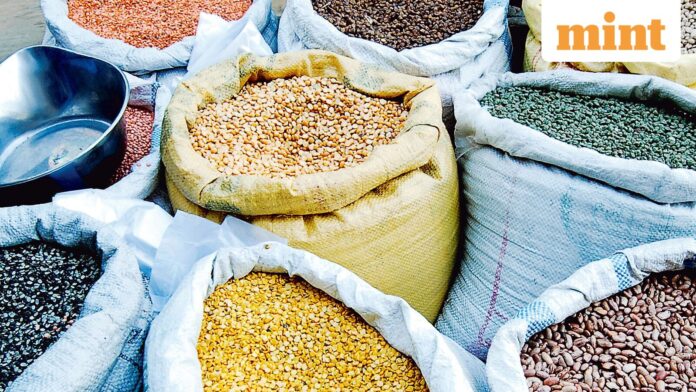A few varieties have already been developed, and efforts are on to scale up more such breeds. These short-duration types of tur mature in 140–150 days, compared to the traditional crops that take 170–180 days, enabling farmers in northern states to expand tur acreage while freeing land for other crops in the same cycle, they said.
The initiative aims to diversify and expand the area under tur, which currently accounts for 39% of pulses acreage, or about 4.58 million hectares. Tur, along with urad, masoor, and chana, forms the bulk of India’s pulse imports, which have been rising amid strong demand and stagnant yields. According to government data, around 20-21% of India’s pulses consumption in fiscal year 2025 (FY25) was met via imports.
Early-maturing varieties would give farmers in non-traditional regions, particularly the north, the flexibility to grow tur without affecting the rabi crop cycle, they added.
“We are focusing on developing short-duration or early-maturing varieties so that they can be widely adopted. These varieties mature in 140–150 days compared to medium and long-duration varieties, which mature in 170–180 days,” said Mangi Lala Jat, secretary, Department of Agricultural Research and Education (DARE), and director general, Indian Council of Agricultural Research (ICAR).
The move is expected to boost domestic output, curb import dependence, and meet growing consumer demand for pulses, a critical source of protein for millions of households.
“We are also working on genome-edited pulses with higher yields,” added Jat. The key difference between genome-edited and genetically-modified (GM) crops is that genome-edited crops involve modification of the plant’s own genes, while GM crops involve insertion of genes from external sources.
Earlier, Mint reported on 3 December 2024 that the Centre has identified two million hectares of fertile land across the country for growing tur (arhar), urad, and masoor varieties, which India currently imports from countries such as Mozambique, Myanmar, Canada, and Australia. These two million hectares are part of a total of four million hectares of watershed land earmarked for farming. Watershed land is where rainwater collects and flows into rivers, streams, or lakes, providing sufficient moisture for pulse cultivation.
Also, in the Union Budget for 2025-26, finance minister Nirmala Sitharaman announced the launch of a six-year “Mission for Aatmanirbharta in Pulses”, with a special focus on tur, urad and masoor. The mission will place emphasis on the development and commercial availability of climate-resilient seeds, enhancing protein content, increasing productivity, improving post-harvest storage and management, and assuring remunerative prices to the farmers.
ICAR-Indian Institute of Pulses Research (IIPR), Kanpur, has developed hybrid short-duration tur varieties, namely IPH 15-3 and IPH 9-5, and one variety called IPA 15-6. “The average yield of these varieties is around 20 quintals per hectare, and they mature in 140–150 days,” said G.P. Dixit, director, ICAR-IIPR.
In India, northern regions suitable for tur cultivation primarily include parts of Madhya Pradesh, Maharashtra (central-west), Rajasthan, Uttar Pradesh, and Chhattisgarh (north-central). Uttar Pradesh and Rajasthan are the main areas in the northern belt, though soil type, rainfall, and irrigation availability are key factors.
According to Jat, plans are afoot to introduce the short-duration tur varieties in northern regions such as Punjab and Haryana. “By developing short-duration varieties, we are giving farmers an option to grow pulses instead of paddy in the same season,” added Jat.
Self-sufficiency in pulses reduces import dependence, stabilizes prices, and ensures reliable access for all. It also supports the livelihoods of millions of Indian farmers. Pulses improve soil health through nitrogen fixation, reducing the need for chemical fertilizers and making agriculture more sustainable.
According to data from the Directorate General of Commercial Intelligence and Statistics (DGCIS), India imported 2.466 million tonnes (mt) of pulses in 2020-2.127 mt in 2021-22, 2.496 mt in 2022-23, rising sharply to 4.739 mt in 2023-24 and reaching a record 6.7 mt in 2024-25. Data from the Department of Agriculture and Farmers Welfare (DAFW) show that India produced 25.463 mt in 2020-21, 27.302 mt in 2021-22, 26.058 mt in 2022-23, before declining to 24.246 mt in 2023-24, and rising again slightly to 25.238 mt in 2024-25.
On 23 September, Union agriculture minister Shivraj Singh Chouhan approved the procurement of major pulses in Uttar Pradesh and Gujarat for the 2025-26 kharif season. The move aims to ensure better prices for farmers and protect them from price crashes.
Chouhan approved 100% procurement of urad and tur, as well as moong. For Uttar Pradesh, 227,000 tonnes of urad worth ₹1,777.30 crore, 114,000 tonnes of tur worth ₹910.24 crore, and 1,983 tonnes of moong worth ₹17.38 crore will be procured. For Gujarat, 47,780 tonnes of urad worth ₹372.68 crore and 4,415 tonnes of moong worth ₹38.71 crore will be procured.
tur cultivation,short-duration tur varieties,Indian farmers,domestic output,tur prices,agriculture,rabi,kharif,pulses imports,crops
#India #develops #earlyharvest #tur #stabilize #prices #pulses #curb #imports

